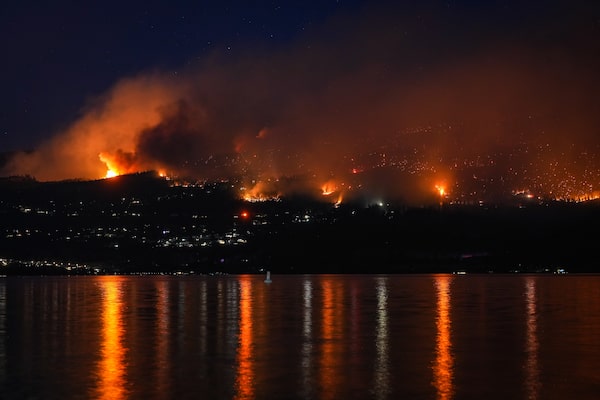
The McDougall Creek wildfire burns on the mountainside above lakefront homes in West Kelowna, B.C., on Aug. 18, 2023.DARRYL DYCK/The Canadian Press
Climate experts are warning that B.C.’s spring wildfire season could be worse than normal, and the provincial government is urging people to preregister for emergency support now to avoid long wait times in case they are forced from their homes.
A Monday update in Vancouver from provincial and federal forecasters underscored the risks posed by the current drought parching parts of British Columbia and leading to an average snowpack 66 per cent of normal, which is tied with 2001 for the second-lowest amount in the past five decades.
Officials said numerous holdover wildfires in the northeast have smouldered through the winter, and once the snow melts and the land dries out, moderate winds will be enough for them to start burning again.
The officials, joined at the press conference by three provincial ministers, said they were providing the warning to prepare people for more fires to ignite if 40 millimetres to 60 mm of precipitation needed to return conditions to more normal levels do not come in the next two weeks.
“Obviously, we’re seeing almost 20 C weather right now, so there’s a bit of heightened concern,” said Cliff Chapman, director of provincial operations for the BC Wildfire Service. “We are doing this earlier than we have ever done it before – we are providing information to, ideally, all of B.C. very early ahead of what we would call the core wildfire season.”
Canada’s 2023 fire season was the most destructive ever recorded. It burned more than 180,000 square kilometres by the end of September, including more than 28,000 square km of land in B.C., where hundreds of homes were destroyed in the Okanagan and Shuswap regions.
Mass evacuations in the central Okanagan, in particular, created long lines at Emergency Support Services stations, Bowinn Ma, the Minister of Emergency Management and Climate Readiness, noted on Monday. That’s why the province has rolled out the ability for people to enroll online now for this type of aid – before they may need it.
“We have to be ready to support more people than ever before,” Ms. Ma told reporters. “We want people to be able to access the supports that they need quickly during an emergency.”
She added: “With an online profile, people who have been evacuated may opt to receive financial services via Interac e-transfer.”
She added that her government also recently announced the streamlining of a training course from one week to one day for volunteers that want to help deliver this type of assistance to people in their region.
Mr. Chapman also said that the BC Wildfire Service is better prepared this season after improving how it communicates and works with locals who are keen to help pitch in on fighting the flames threatening their homes, referencing the conflict with people in the Shuswap region last summer. In August, volunteers there were admonished for defying evacuation orders and staying behind to fight the blazes with makeshift equipment.
He added that the firefighting service has also expanded its full-time staffing outside of the seasonal corps of summer firefighters that usually get hired this month or next. Mr. Chapman couldn’t provide exact numbers, but said that, over the past two years, BC Wildfire Service has doubled its base of all-year firefighters and support staff.
Premier David Eby told an earlier Monday news conference, where he announced $80-million to help farmers cope with drought, that the province “can’t afford to be subtle” when it comes to climate change.
“We are seeing records set for everything from drought to snowfall to heat, and what we are hearing from experts is that this summer might be a very difficult one,” he said.
The Premier attributed the conditions to the cumulative effects of low snowpack, drought and higher temperatures.
With reports from The Canadian Press